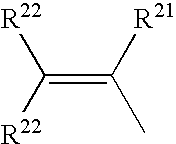Carboxylic tris-like siloxanyl monomers
a carboxylic tris-like, monomer technology, applied in the field of polymer compositions, can solve the problems of poor wettability and comfort, poor soluble in water, and hydrophobicity, and achieve the effects of high oxygen permeability, desirable biocompatibility and comfort, and high oxygen permeability
- Summary
- Abstract
- Description
- Claims
- Application Information
AI Technical Summary
Benefits of technology
Problems solved by technology
Method used
Image
Examples
example 1
Synthesis of Carboxylic Siloxanyl Monomer
[0079]This method is adapted from a literature procedure: Zilkha, A and Golik, U. J. Org. Chem. 1963, 28, 2007-2009. To a stirred solution of itaconic anhydride (4.24 g, 37.8 mmol) in CHCl3 (40 mL) is slowly added 3-aminopropyltris(trimethylsiloxy)silane (15.1 mL, 38.0 mmol) at 0° C. under a nitrogen atmosphere. The cooling bath is removed and the solution allowed to warm to ambient temperature and stirred under a nitrogen atmosphere an additional 15 h. Following removal of solvent at reduced pressure, the viscous, clear oil is analyzed via mass spectrometry to confirm the presence of the proposed structure.
[0080]
example 2
Polymerization, Processing and Properties of Films Containing Carboxylic Siloxanyl Monomers
[0081]Liquid monomer solutions containing carboxylic siloxanyl monomers from example 1 above, along with other additives common to ophthalmic materials (diluent, initiator, etc.) are clamped between silanized glass plates at various thicknesses and polymerized using thermal decomposition of the free-radical generating additive by heating 2 h at 100° C. under a nitrogen atmosphere.
example 3
Synthesis of Carboxylate Siloxanyl Monomer
[0082]Using methods well known in the art, the product from example 1 can be converted by treatment with base and optionally ion-exchange to afford carboxylate derivatives as shown below.
[0083]
PUM
| Property | Measurement | Unit |
|---|---|---|
| Mn | aaaaa | aaaaa |
| thickness | aaaaa | aaaaa |
| width | aaaaa | aaaaa |
Abstract
Description
Claims
Application Information
 Login to View More
Login to View More - R&D
- Intellectual Property
- Life Sciences
- Materials
- Tech Scout
- Unparalleled Data Quality
- Higher Quality Content
- 60% Fewer Hallucinations
Browse by: Latest US Patents, China's latest patents, Technical Efficacy Thesaurus, Application Domain, Technology Topic, Popular Technical Reports.
© 2025 PatSnap. All rights reserved.Legal|Privacy policy|Modern Slavery Act Transparency Statement|Sitemap|About US| Contact US: help@patsnap.com



